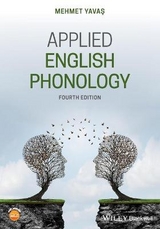
Applied English Phonology
John Wiley & Sons Inc (Verlag)
978-1-118-94452-3 (ISBN)
- Titel erscheint in neuer Auflage
- Artikel merken
Mehmet Yava is a Professor of Linguistics at Florida International University, USA. He has published numerous articles on applied phonology. His other publications include Unusual Productions in Phonology: Universals and Language-Specific Considerations (2015), Phonology: Development and Disorders (1998), First and Second Language Phonology (1994), Phonological Disorders in Children (1991), and Avaliacao fonologica da crianca (1990), a phonological assessment procedure for Brazilian Portuguese.
Companion Website ix Preface to Third Edition x Note to the Instructor xi Abbreviations xiii Chapter 1 Phonetics 1 1.1 Introduction 1 1.2 Phonetic Transcription 1 1.3 Description and Articulation of Sounds of English 4 1.3.1 The vocal tract 4 1.3.2 Voicing 5 1.3.3 Places of articulation 6 1.3.4 Manners of articulation 7 1.3.5 Voice onset time 9 1.3.6 Vowels and diphthongs 11 1.4 Additional Sounds 13 1.4.1 States of the glottis 13 1.4.2 Places and manners of articulation 13 1.4.3 Secondary articulations 17 1.4.4 Consonants made with non pulmonic airstream mechanisms 17 1.4.5 Vowels 19 1.5 Cardinal Vowels 19 1.6 Syllables and Suprasegmentals 20 Summary 24 Exercises 24 Chapter 2 Phonology 31 2.1 Introduction 31 2.2 Complementary versus Overlapping Distribution 32 2.2.1 Overlapping distribution and contrast 32 2.2.2 Complementary distribution 34 2.3 Phonemic Analysis: A Mini Demo 38 2.4 Free Variation 46 2.5 Morphophonology 47 2.6 Practical Uses of Phonological Analysis 49 Summary 52 Exercises 53 Chapter 3 English Consonants 59 3.1 Stops 59 3.2 Fricatives 65 3.3 Affricates 68 3.4 Nasals 69 3.5 Approximants 71 3.6 Sociophonetic Variation 74 Summary 75 Exercises 75 Chapter 4 English Vowels 80 4.1 Introduction 80 4.2 Vowel Set of American English 80 4.2.1 Phonetic properties of vowels 81 4.2.2 Tense lax 82 4.2.3 Nasalized vowels 83 4.2.4 Length 84 4.2.5 Vowels before / / 84 4.2.6 Vowels before /l/ 85 4.3 Front Vowels 86 4.4 Central Vowels 87 4.5 Back Vowels 88 4.6 Diphthongs 89 4.7 Sociophonetic Variation 92 4.8 Non US Varieties 92 4.9 Full Vowels Reduced Vowels 95 4.10 Full (Strong) Forms versus Reduced (Weak) Forms of Function Words 97 Summary 99 Exercises 100 Chapter 5 Acoustics of Vowels and Consonants 104 5.1 Introduction 104 5.2 Spectrographic Analysis 106 5.3 Vowels and Diphthongs 107 5.4 Consonants 112 5.4.1 Obstruents 112 5.4.2 Sonorant consonants 120 5.5 Putting it Together 122 5.6 Waveform Analysis 125 5.7 Context 141 5.8 Practical Applications: Some Examples 143 Summary 145 Appendix 146 Exercises 148 Chapter 6 Syllables 154 6.1 Introduction 154 6.2 Number of Syllables 157 6.3 Sonority 158 6.4 Syllabification 160 6.5 English Syllable Phonotactics 162 6.5.1 Single onsets 163 6.5.2 Double onsets 163 6.5.3 Triple onsets 165 6.5.4 Codas 166 6.5.5 Double codas 166 6.5.6 Triple codas 166 6.6 Written Syllabification 170 6.7 Syllable Weight and Ambisyllabicity 173 6.8 Practical Applications 174 Summary 177 Exercises 177 Chapter 7 Stress and Intonation 180 7.1 Introduction 180 7.2 Noun and Adjective Stress 181 7.3 Verb Stress 184 7.4 Secondary Stress 186 7.5 Affixes 188 7.5.1 Stress bearing (attracting) suffixes 189 7.5.2 Stress neutral suffixes 189 7.5.3 Stress shifting (fixing) suffixes 190 7.6 Stress in Compounds 192 7.7 Differences between American and British English 193 7.8 Intonation 196 7.9 Variations among the Varieties 201 Summary 202 Exercises 203 Chapter 8 Structural Factors in Second Language Phonology 206 8.1 Introduction 206 8.2 Spanish English Mini Contrastive Analysis 210 8.3 Differential Treatment of Mismatches 215 8.3.1 Basic vs. derived context 216 8.3.2 Deflected contrast 217 8.3.3 Hypercontrast 218 8.4 Markedness 218 8.5 Ontogeny Phylogeny Model (OPM) 225 8.6 Optimality Theory (OT) 227 8.7 Perception 231 8.8 Bilingual Phonology 237 8.9 Loan Phonology 240 Summary 242 Appendix A 243 Appendix B 251 Exercises 252 Chapter 9 Spelling and Pronunciation 255 9.1 Irregularity of English Spelling 255 9.2 Phoneme Grapheme Correspondences in English 257 9.2.1 Consonants 257 9.2.2 Vowels 261 9.3 Morphological Basis of English Spelling 265 9.4 American English vs. British English 267 Summary 269 Exercises 270 Recommended Readings 273 Appendix: List of Sound Files 276 Glossary 281 References 288 Index 298
| Erscheint lt. Verlag | 19.1.2016 |
|---|---|
| Verlagsort | New York |
| Sprache | englisch |
| Maße | 195 x 238 mm |
| Gewicht | 644 g |
| Themenwelt | Schulbuch / Wörterbuch ► Wörterbuch / Fremdsprachen |
| Geisteswissenschaften ► Sprach- / Literaturwissenschaft ► Sprachwissenschaft | |
| Sozialwissenschaften ► Pädagogik ► Bildungstheorie | |
| ISBN-10 | 1-118-94452-6 / 1118944526 |
| ISBN-13 | 978-1-118-94452-3 / 9781118944523 |
| Zustand | Neuware |
| Informationen gemäß Produktsicherheitsverordnung (GPSR) | |
| Haben Sie eine Frage zum Produkt? |
aus dem Bereich



